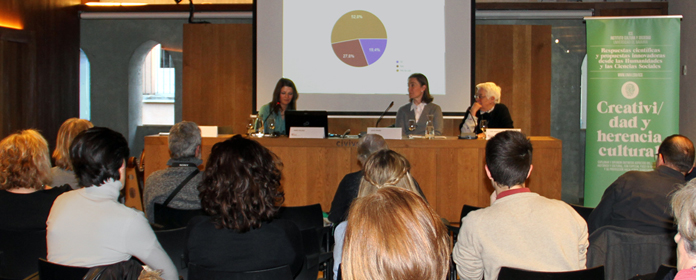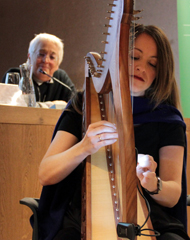"The research financial aid to recover the past of Sepharad and the cinema and literature contribute to make it attractive to the public."
Anna Dulska, researcher at Institute for Culture and Society, added at the framework of the III workshop Sefarad that music "allows today's Sephardim to maintain their identity and report and to live it in the present".

PHOTO: Natalia Rouzaut
"The research financial aid to recover the past of Sepharad and literature and cinema contribute to make it attractive to the public". This is the opinion of Anna Dulska, researcher at the project 'Creativity and Cultural Heritage' of the Institute for Culture and Society (ICS) of the University of Navarra, on the occasion of the 3rd Sepharad workshop .
This edition of the activity has been graduate 'Sepharad imagined and represented (literature and documentary film in feminine)' and has highlighted the female figure in the framework of Women's Day (March 8). It was attended by the writer Toti Martínez de Lezea, who recreated the Sephardic past in several of her works, and hosted the European premiere of the documentary 'In Search of Sepharad', by the Argentine journalists Carina Gurovitz and Paula Castiglioni.
In the framework of the event, Anna Dulska has offered some details about the project that she is developing, which has as goal to know the report of the past of the Sephardim. For this purpose, she is looking for people interested in participating in the study, either by means of a brief questionnaire, or through an interview. It also analyzes one of the centuries-old traditions that have survived to the present day: that the expelled Jews took the keys to their former homes with them in the hope of being able to return one day.
With respect to other lines of research that are being carried out today on Sepharad, he mentioned first of all the programs of study around Jewish texts, kept in various archives. He also mentioned the archaeological work being carried out in different geographical locations to recover the "material culture". He gave as an example the excavations of the Jewish quarter of Estella, "which have served to enhance its value both for the local population and for tourism".
Bringing archaeological finds to lifeFrom agreement with Anna Dulska, these archaeological finds "come alive with the stories told in literature and film", as is the case of a story about a young Jewish girl from medieval Estella that Toti Martínez de Lezea XV has included in the book Voces de Sefarad, presented during the workshop.
 "It is difficult to write about the Age average in Spain in a literary way without talking about the presence of the Jews."The ICS researcher pointed out. "Portraying their daily life, in addition, financial aid to break down stereotypes related to their economic activities. The truth is that they had a very rich culture".
"It is difficult to write about the Age average in Spain in a literary way without talking about the presence of the Jews."The ICS researcher pointed out. "Portraying their daily life, in addition, financial aid to break down stereotypes related to their economic activities. The truth is that they had a very rich culture".
With respect to the documentary cinema, he remarked that "it contributes to recover current stories, giving voice to Sephardic people of today, who remember a world that no longer exists: a still photo of the Iberian Peninsula of the 15th century". In this line, he valued the work of América TV journalists Carina Gurovitz and Paula Castiglioni, who in their documentary 'In Search of Sepharad' have portrayed the life of the Sephardic community in Buenos Aires, the largest in the Hispanic world, and their efforts to keep their culture and traditions alive.
Finally, Anna Dulska advanced that music will be present in subsequent editions of the workshop Sefarad because of its importance for the Sephardim: "Les financial aid to maintain their identity and report of the past and live it in the present". It should be recalled that the 2019 workshop featured a surprise performance by the Navarrese artist Maite Itoiz, who interpreted two songs in language ladino.




